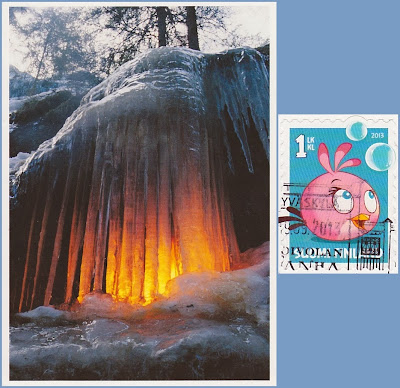FINLAND - NATURE
 Lakes
Lakes
Finland is the country with the most waters in the whole world. 10% of Finland's surface is covered by lakes. There are 187,888 lakes in Finland larger than 5 ares (500 square metres). Most are
small, but there are 309 lakes or reservoirs larger than 10 km².

Nice stamps.
Received from: Winkkara
Winter greetings
 Winter usually begins in mid-October in Lapland and during November in the rest of Finland, though not until December in the southwestern archipelago. It thus takes about two months for winter to proceed from Lapland to Åland. The sea and large lakes slow down the progress of winter. Winter is the longest season in Finland, lasting for about 100 days in southwestern Finland and 200 days in Lapland. North of the Arctic Circle, part of winter is the period known as the "polar night", when the sun does not rise above the horizon at all. In the northernmost corner of Finland, the polar night lasts for 51 days. In southern Finland, the shortest day is about 6 hours long.
Winter usually begins in mid-October in Lapland and during November in the rest of Finland, though not until December in the southwestern archipelago. It thus takes about two months for winter to proceed from Lapland to Åland. The sea and large lakes slow down the progress of winter. Winter is the longest season in Finland, lasting for about 100 days in southwestern Finland and 200 days in Lapland. North of the Arctic Circle, part of winter is the period known as the "polar night", when the sun does not rise above the horizon at all. In the northernmost corner of Finland, the polar night lasts for 51 days. In southern Finland, the shortest day is about 6 hours long.

A nice stamp.
Received from: Siru62
 Tourist centre at Sallatunturi Fjeld
Tourist centre at Sallatunturi Fjeld
A beautiful stamp.
 Received from: gimaho
Received from: gimaho
 Forests
Forests
Finland is the most extensively forested country in
Europe. Forests cover 86 percent of its land area. There are about four and half
hectares of forest to every Finn.

Nice stamps.
Received from: Aqality
 Finland
Finland
The landscape is covered mostly
(seventy-five percent of land area) by coniferous taiga forests and fens, with
little arable land. The most common type of rock is granite. It is a ubiquitous
part of the scenery, visible wherever there is no soil cover. Moraine or till
is the most common type of soil, covered by a thin layer of humus of biological
origin. Podzol profile development is seen in most forest soils except where
drainage is poor. Gleysols and peat bogs occupy poorly drained areas.

A nice Moomin stamp.
Received from: Elmanaakka
 Baltic Sea
Baltic Sea
The Baltic Sea is a brackish mediterranean sea located in
Northern Europe. It is bounded by the Scandinavian
Peninsula, the mainland of Europe,
and the Danish islands. The Baltic Sea occupies a basin formed by glacial erosion during the last few Ice Ages. During winter, fast ice, which is
attached to the shoreline, develops first, rendering the ports
unusable without the services of icebreakers. In spring, the Gulf of Finland and the Gulf of Bothnia normally thaw during
in late April, with some ice ridges persisting until May in the eastern
extremities of the Gulf of Finland. In the northernmost reaches of the Bothnian
Bay, ice usually stays until late May; by early June it is practically always
gone.

A nice stamp.
Received from: cicus
Autumn colours at Pallastunturi
 Pallas-Yllästunturi National Park is Finland’s third largest National Park. Geologically Pallas-Yllästunturi National Park is located between Northern
Finland, Forest Lapland and Fell Lapland, making it a very varied and
interesting habitat. In the park’s forests and on its fells there is a mix of
northern and southern species. It is also the area in which visitors can see the
transition area where peoples livelihood changes from farming to reindeer
husbandry. The picturesque beauty of the Pallastunturi Fells has made the area one of the
Finnish national landscapes.
Pallas-Yllästunturi National Park is Finland’s third largest National Park. Geologically Pallas-Yllästunturi National Park is located between Northern
Finland, Forest Lapland and Fell Lapland, making it a very varied and
interesting habitat. In the park’s forests and on its fells there is a mix of
northern and southern species. It is also the area in which visitors can see the
transition area where peoples livelihood changes from farming to reindeer
husbandry. The picturesque beauty of the Pallastunturi Fells has made the area one of the
Finnish national landscapes.

A nice stamp.
Received from: Lilla
 A Frozen Waterfall
A Frozen Waterfall
Waterfalls are one of nature’s most dynamically beautiful phenomena, even when the water isn’t falling. This postcard of a frozen waterfall shows what happens when Mother Nature decides to take a snapshot of her most moving creations. Finland in winter is a frozen waterfall paradise.
A nice stamp.
Received from: Sami















Žádné komentáře:
Okomentovat